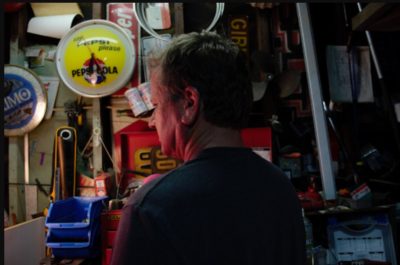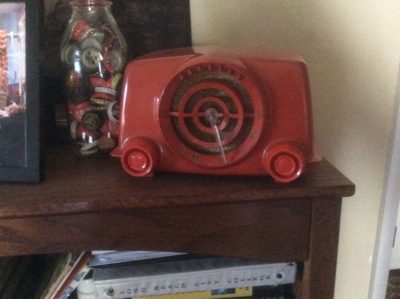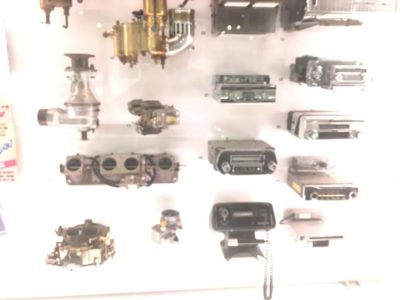Abandonment issues
January 9, 2021
Text by Caryn Aasness with Jon Aasness
“I had a notepad. And if I saw something that was not for sale, I’d still write it down. If it was something that was for sale, I would usually go back and buy it.”
My artistic practice has recently been focused on objects: our relationships to them, and the distinction between collecting and hoarding. I spoke with my dad Jon Aasness to get his insight as a person interested in objects and their histories. He is a retired employee of the Southern California Gas Company, and the first person to introduce me to the magic of “junk.”

Caryn Aasness: Do you collect anything?
Jon Aasness: I don’t have any official collections, I don’t think, but I collect a lot of things. At some points I collect cars. I try to limit my collections.
Caryn: What makes a collection official? You said you don’t have any official collections?
Jon: Yeah, you know what I think? I think part of that is being organized versus just, some of my stuff is unorganized. So I wouldn’t consider it an actual collection [if it is disorganized]. When I think of if I had a collection, I would have the case to put the things in and to display them.
Caryn: Where have you found some of your favorite objects?
Jon: At abandonments. I’d go to an abandoned house, where I’d have to be there for work and find interesting stuff. Architectural salvage type stuff, where it’s just like, oh, man, that is cool. I’d love to drag that home but I often didn’t, because they’re either big or I don’t really necessarily need it in my home.
Caryn: That kind of leads into another question I have, which is, if something’s free, how do you decide whether or not to take it?
Jon: Yeah, that’s a good question. Because it used to be that I would bring home tons of stuff and stuff that I didn’t need. But now I try to get stuff that I know I could use, or that I need. I have to force myself but you know, small house, I can’t bring a ton of stuff home. Sometimes I’ll say, Oh, you know what, somebody else probably could use that more than me. And I will let it go. That’s how I justify leaving something that’s just killer.
Caryn: If it’s in an abandonment, are there going to be more people going through the house after you?
Jon: Yes. So that was one of the things. Well, when I worked in Redondo Beach, I would cheat a little bit because they have a board in the office, and I just go in my office, and I’d look and there’s a board of upcoming abandonments, and I’d write down addresses. When I worked the four to midnight shift, and I had downtime, sometimes I would get to work and there would be nothing for me to do. So I just go to those abandonments. I could write myself an order to pull the meter and be able to check it out. And typically, we would be one of the first people on that abandonment.
Caryn: Does it usually feel like people who were moving out had time to move out what they wanted? Or do people just kind of up and go when they leave a house?
Jon: It is a mix because that was a kind of a unique deal timing wise where people that lived in that house for 30 years and paid $100,000 for it, now sold it for $900,000 and they left the bulk of their stuff. They just pocketed a ton of cash. And they weren’t concerned, they were going to buy all new stuff so people would leave just everything. The garage will be completely full and they just take keepsakes and leave everything else and it was interesting, interesting times.
Caryn: So it’s not like those people in those houses got kicked out?
Jon: No, they were selling and builders were buying the lots. Yeah, that’s what an abandonment is. You go and remove the meter. And then the crew comes and picks it up in the street and pinches the gas because they’re gonna tear the house down. So it was different, I mean, there was a time in 2008, 9, 10, where there were just tons of foreclosures, that was different, those people were leaving, and they didn’t necessarily have a place to go. So they left a lot of stuff behind. That was different. That was sad. The other one was, like, they hit the lottery, and just bailed, two very different things.
Caryn: How did you first become aware of hoarding?
Jon: That’s one thing about my job—going into people’s homes, I saw a lot of hoarding for the last thirty plus years. Thirty years ago, I didn’t know that it was hoarding. I just thought, how can they live like that? There’s a trail leading to the bathroom, the kitchen, and the bedroom; everything else is just piled up to the ceiling.
Caryn: And probably not a trail leading to the water heater.
Jon: Yeah, exactly. I was a nice guy. So I would make a trail if I had to, to get them some hot water. I don’t know if I told you that story about out in Huntington Beach, a multi million dollar neighborhood. This gal, she didn’t have any money but she probably inherited that house. She didn’t want me to look at her water heater. And I told her, “Well, I could look at it.” And she goes, “No, no, no, I don’t want you to go in the garage.” And I had already been in her house. It was disgusting. Animal feces all over the place. Probably human feces as well. But I went out, and she said that the rats have been eating through her water heater, so she knows it doesn’t work. Hmm. And I was able to get it working. She hadn’t had hot water for probably a year. I had to be there. Because the gas was shut off to the whole block or whole neighborhood. We had to go in and restore. Turn the gas back on and stuff and you can’t just say, okay, well, I’ll turn it on. You’re responsible for it in the house. It doesn’t work like that, you know, I can’t turn it back on unless I look at every appliance. So she was embarrassed. And I totally was decent, treated her decently, so she let me in. She just assumed that the water heater quit working because of the rats. That was the one where she said that her neighbor had complained. So the city sent an exterminator to the house and killed, I think it was 16 rats in that one day, then had traps set. And she said she kept hearing them going off all night long. She was alone with a tiny little dog. It wasn’t a chihuahua, it was something smaller than a chihuahua. She wouldn’t set the dog down because of the rodents.
I don’t know that I ever heard [the term] hoarding thirty years ago. It was more just tied with disgust. I mean, you didn’t think about maybe some mental illness working, with something that drastic. I mean, I was in a house one time where there was just stuff everywhere. The floor was like a hoarder’s house. But it was all pornography. That was in Santa Monica. And I was just blown away, like, oh, my gosh, and to see this person standing there in this filth, and just like, oh, my, but I would have never called that hoarding. It was just like this person is just sick. I mean, there was really, really not any furniture or anything. It was just like, wow, what the hell? And at work we would all talk about it. Everybody saw it. We come back at the end of the day and say, “This is the worst one I’ve ever been in!”
Caryn: Is there anyone whose collection you admire?
Jon: One that probably got me started on my collecting or my interest in junk was a farm that I went to in South Dakota, one of my dad’s relatives. He had probably a couple hundred thousand things. I mean, just an unbelievable collection. Little bit of everything—antiques, oddities and just bizarre stuff. His house, his barn, his outbuildings, everything was just packed full of stuff. And I remember being there as a kid. I was probably eight or nine. And he gave me a Dr. Pepper sign. It was new old stock. It was still wrapped in paper. But he had probably 12 of them. He pulled one out and gave it to me. And I was like, oh, this is cool. I was a kid, but I love Dr. Pepper. And it was advertising! That guy had just an unbelievable amount of stuff. And he let people go through and look at his collection. He had stuff displayed, hundreds of thousands of pieces. Some of them are just amazing. But it wasn’t dirty, just dusty and stuff. It was a barn, but he had stuff displayed like this was a kitchen from the 1880’s or whatever. This is a way a kitchen would look in the 1880’s. Just everything you could imagine. This guy had at least one of everything that had ever been produced. I mean, it was incredible. But he just had always been a collector. He just had a regular nine to five job, but he just collected from an early age, and he just appreciated older things. That one stuck in my head. I still have the sign that he gave me.


Caryn: Are there objects that you have gotten rid of that you still think of?
Jon: Yeah, it’s kind of interesting that collecting was the kind of thing that’s completely different now. Because back in the day, I wouldn’t mind getting rid of something because there’s always something better. So usually, when I got rid of something, it was because I had my eye on something else. And it was the kind of thing where you can wait a couple of weeks and something interesting is going to pop up in the area that we live in. There were so many cars and nobody cared about them. And usually, you’d find something even cooler than what you had but there were a few cars I regret selling. But I still probably would have sold them because there’s something even more interesting in that next garage that I go in or whatever, but I still maybe regret selling a couple of cars.
Caryn: Can you talk a little bit about your mental map of all the cars on your work routes?
Jon: Yeah, I actually had notes, I had a notepad. And if I saw something that was not for sale, I’d still write it down. If it was something that was for sale, I would usually go back and buy it. But I did. I kept track of cars when I was working in Redondo, and then I was working in Orange County. And I typically have twenty, maybe thirty cars that I knew where they were, and maybe check up on them every once in a while. I just was looking and I actually found one of my old notebooks. It was from 2004. Because I knew in downtown Huntington Beach there was a garage that I went into, where there was a Porsche speedster sitting there. I asked and it was not for sale. But it was kind of an interesting situation. And that’s the thing, they all have stories, it was her husband’s car. He was no longer living. He was a mechanic. He had tons of parts, he probably had other hundred thousand dollars worth of Porsche parts sitting in the garage there, but she just wasn’t at the point where she was going to sell anything. I never even went back and I just had it in my notes. And then I was like, I know, I wrote that down. And I went back and found it. It’s sitting on my nightstand right now, that address.
Caryn: How do you know when to get rid of something?
Jon: Well you know me, I don’t get rid of a lot.
Caryn: I don’t think that’s true.
Jon: I mean, I used to just collect stuff. Just, it was cool. But at that point, it becomes like a hoarding situation where nobody’s enjoying it. You see those shows, and it’s like, oh, yeah, I know, there’s some really cool stuff in that room, from an eight foot ceiling, you know, you get down about seven feet. That’s where the cool stuff is. But somebody could get some joy out of it if you pass it on.
Caryn: Final thoughts?
Jon: You know what I always pictured, like having a collection, for me, it would probably be automotive related. Like, if you go to the Petersen Museum, you see how they display stuff, it’s like, not just the cars, they’ve got their cars laid out. And then they have cases with radios or carburetors or different things. When I see that it’s like, wow, that’s what I would like to have, where you can just appreciate it. That’s my collection, not just something that I purchased but you could actually appreciate it, not sitting in a box somewhere in the attic. I would like to organize my garage one of these days and get some stuff up on the shelf.

Caryn: If you could ask the reader of this interview a question, what would you want to know?
Jon: If they had the space and money, what would they collect? Or, if they ended up with someone’s collection, would they keep it, or any of it?

Caryn Aasness is an artist and grad student living in Portland, OR.
Jon Aasness is a retired gas company technician living in Long Beach, CA.


